Best exotic fruits of the Dominican Republic to try in 2025
The Dominican Republic boasts a huge variety of fruits that ripen here almost all year round. Some of them are known to all: pineapples, watermelons, melons and bananas will not surprise us. Although you can tell something interesting about them. Of course, there are seasons when some fruit crops bear more fruit than others: for mango it is, for example, June, and for pineapple – August.
In general, the Dominican Republic is just a heavenly place for fruit lovers: almost at any time of the year you can enjoy not only the already mentioned mango and pineapple, but also passion fruit, several types of bananas, green and dry coconuts, papaya, guava, avocado, guanábana, watermelon and melons.
In certain months, the Dominican Republic will spoil you with exotic fruits such as pitahaya, limoncillo, mammon, golden apple, granadilla or passion fruit, caimito or star apple, carambola, nispero or loquat and sapote. All of them, except for mangoes, are also available in any season. The “King of Fruits” ripens throughout the country from March to October. And only in one of the villages, Baní, mango does grow all year round.
Dominican exotic fruits
1. Guava fruit
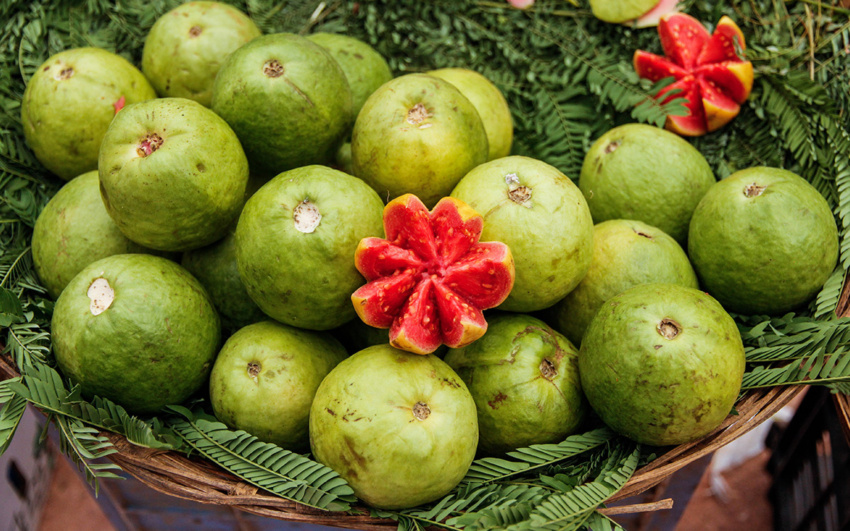
Guava fruit
It is a hard-green fruit similar in shape to a pear. Inside – sweet and sour white or pink flesh with a musky scent. Guava is native to Central America. It treats many ailments, from asthma to intestinal disorders. Ripe guava is eaten whole, along with the skin. And unripe ones are peeled and used as a side dish for meat dishes.
2. Passion fruit or Chinola

Passion fruit or Chinola
Round, wrinkled, yellowish-green, scary-looking “fruit of passion” is loved the most than all Dominican fruits. There is so much tonic vitamin C here that chinola can easily replace strong espresso. In its pure form, it is sour, so Dominicans with a sweet tooth eat it like this: cut it in half, pour sugar or honey inside and scoop out the pulp with a spoon along with the seeds. Be sure to taste the freshly squeezed chinola juice – you will never forget this taste.
3. Guanábana, or Annona, or Soursop
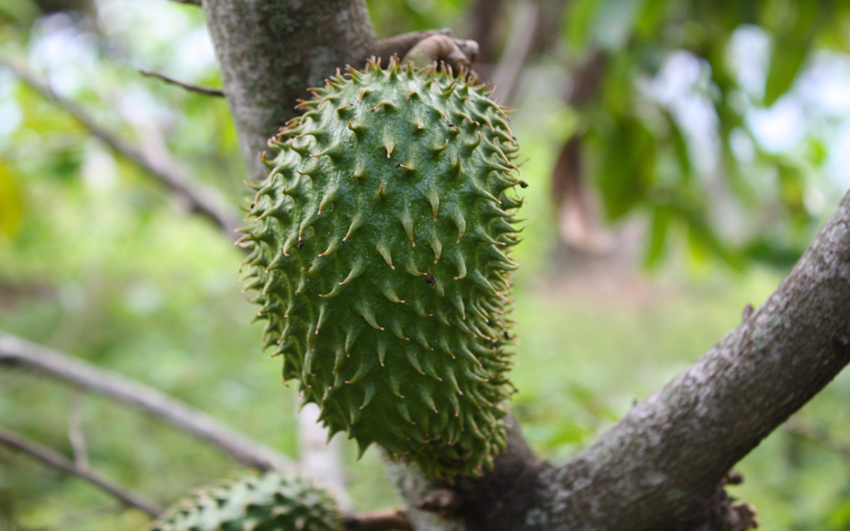
Guanábana, or Annona, or Soursop
Guanábana looks like an overgrown green melon with soft black spines. Inside it is white. It is usually sold unripe, that is why guanábana has a reputation for being healthy, but tasteless. The secret is to let the hard guanábana lie for a couple of days until it softens. Then it will acquire its unusual sweet and sour taste. We can say that it is the most powerful anticarcinogen on the planet and surpasses even modern methods of treatment in terms of its effect on cancer cells.
4. Cherimola, or Cherimoya, or Custard apple
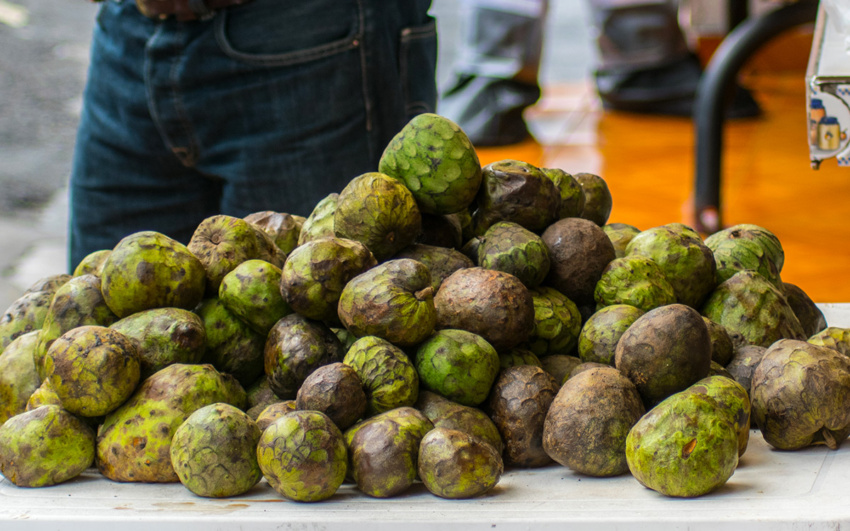
Cherimola, or Cherimoya, or Custard apple
“Fruit-cone”, as the people cherimola, is really similar in shape to a soft green cone. It tastes amazing – the white, sweet pulp resembles vanilla yogurt or custard. Large black seeds are not eaten. In addition to its pleasant taste, it contains a decent list of minerals and vitamins. In some countries, cherimola pulp is used in the manufacture of sorbet, added to ice cream.
5. Pitahaya or Dragon fruit
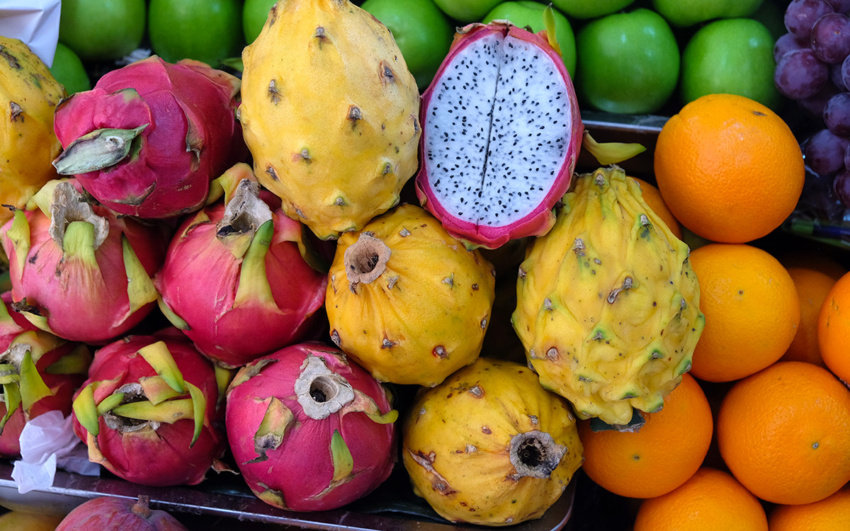
Pitahaya or Dragon fruit
It comes from the cactus family. It’s hard to imagine a fruit more exotic in appearance than the large, colorful, bright pink pitahaya. It is cut in half and the sweetest white or pink flesh is eaten away with a spoon. This is not just a delicacy – doctors recommend pitahaya as a remedy for stomach pains and endocrine diseases.
6. Limoncillo, or Mamoncillo, or Spanish lime

Limoncillo, or Mamoncillo, or Spanish lime
There are no grapes in the Dominican Republic (only imported), but there is a local alternative – limoncillo. Small round fruits grow in clusters, taste pleasantly sour, peel with difficulty. Be very careful: getting limoncillo juice off your clothes is not an easy task. Latin American women are convinced that it is thanks to this fruit that their skin remains young and elastic for so long.
7. Noni fruit

Noni fruit
In the Dominican Republic there is no durian, but there is a noni fruit. These two fruits are similar with a nasty and pungent smell: several of ripe noni will bring the scent of the basement, in which the moldy cheese is stored, into your kitchen. The taste of noni is also not for everybody – it is like a slightly bitter overripe pineapple.
But in terms of useful properties, noni will give odds to almost all other fruits. It is called “the fruit of youth.” It contains absolutely all the elements of the periodic table that are important for our body. Locals know about this and make juice from noni – and drink it cold or warmed daily.
8. Granadilla

Granadilla
It is a variety of passion fruit that is popular in Asia. In the Dominican Republic, it is rare, but the taste is even sweeter than Thai. Break the dense orange or red peel and scrape it off with a spoon, or suck out the translucent sweet pulp right with the seeds. There is a lot of ascorbic acid here.
9. Sea grapes, or Uva de playa, or Beach grapes
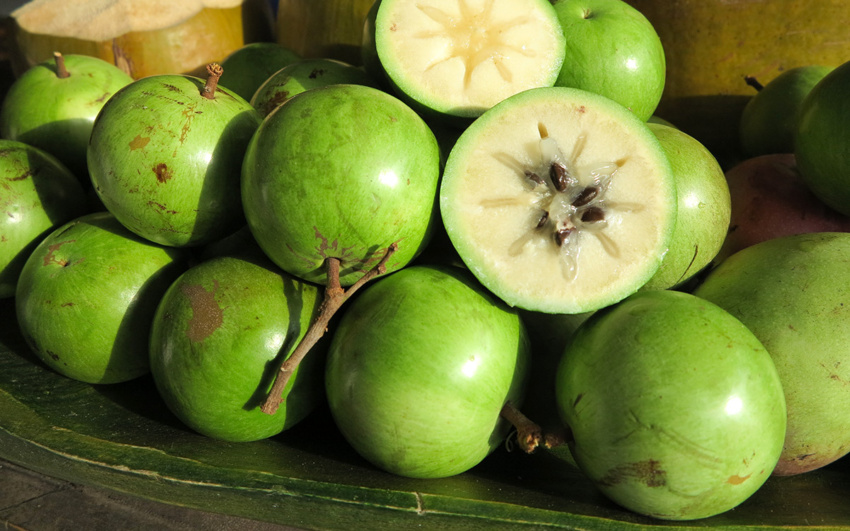
Sea grapes, or Uva de playa, or Beach grapes
Outwardly, this fruit really resembles grapes, but the taste is not. It grows on the coast, hence the name “sea” or “beach”. The main difference between sea grapes is that it has a huge seed (2/3 of the fruit size), and very little pulp. The color is green in its immature state, and when it ripens, it becomes bright purple. The taste can be sweet or sour, depending on the variety and the weather conditions in which the fruits ripened.
Sea grapes grow everywhere, and are specially planted along the beach line to strengthen the soil and block the beach from the noise and light of settlements. Just remember to wash the fruit before eating. Ripe fruits are easily separated from the bunch. Just put a bag on the bunch and shake, ripe fruits will fall into the bag.
10. Caimito or Star apple
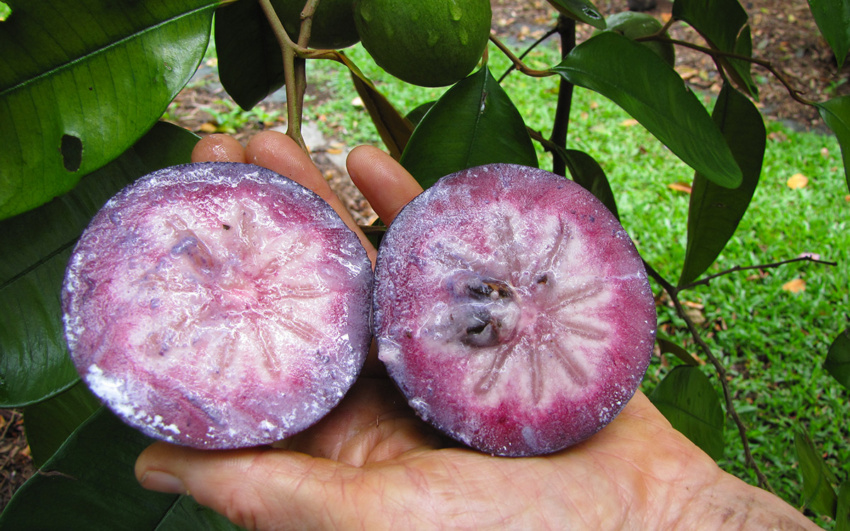
Caimito or Star apple
Caimito looks like a plum with an inedible skin and sweet purple-white flesh, and if you cut it in half, you will see a “star” from the seeds. The composition is also stellar: there is vitamin C, and calcium, and potassium. And also caimito is a constant participant in the ratings of the most delicious fruits in the world. It is somewhat reminiscent of a very ripe persimmon, but not so knit and leaves an unusual sour aftertaste.
11. Breadfruit or Buen pan
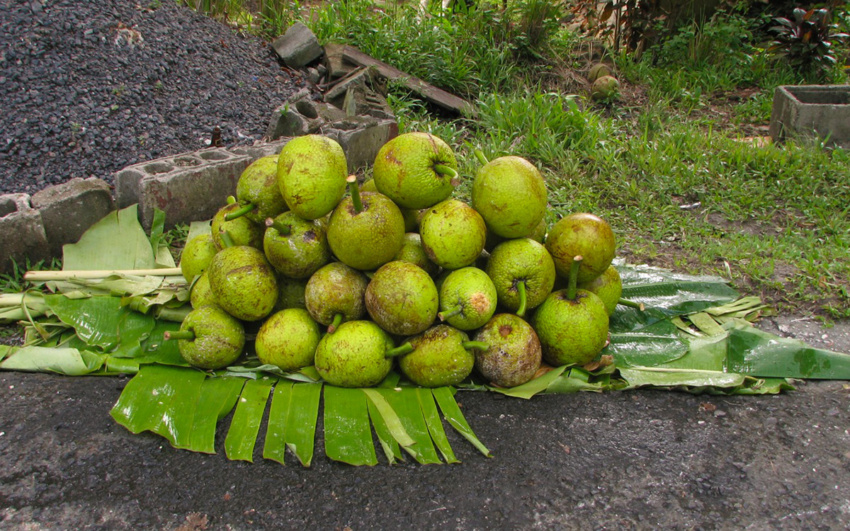
Breadfruit or Buen pan
This fruit is not usually eaten raw, although it is safe as well. It is usually peeled, then fried or boiled. In the Dominican Republic, people prefer to fry pieces in oil, called “tostones” or “mofondo”. However, almost any fruit is fried in oil here, and all these dishes are called “tostones”. The breadfruit comes from New Guinea and was brought to the Caribbean by Europeans to feed slaves. And since then, the attitude towards these fruits has not changed, they are considered low-grade food. Most often, breadfruit is used for livestock feed.
The breadfruit has a gigantic yield – up to 150 fruits per year, the weight of each fruit – from 800 grams to 2 kilograms. The tree is unpretentious, does not require maintenance. Therefore, many scientists predict the role of breadfruit as one of the main food products of mankind by the end of the 21st century. Probably, for our children and grandchildren, these fruits will become an integral part of the diet. We can say that this is the “taste of the future.” The taste is somewhat similar to potatoes.
12. Carambola or Star fruit
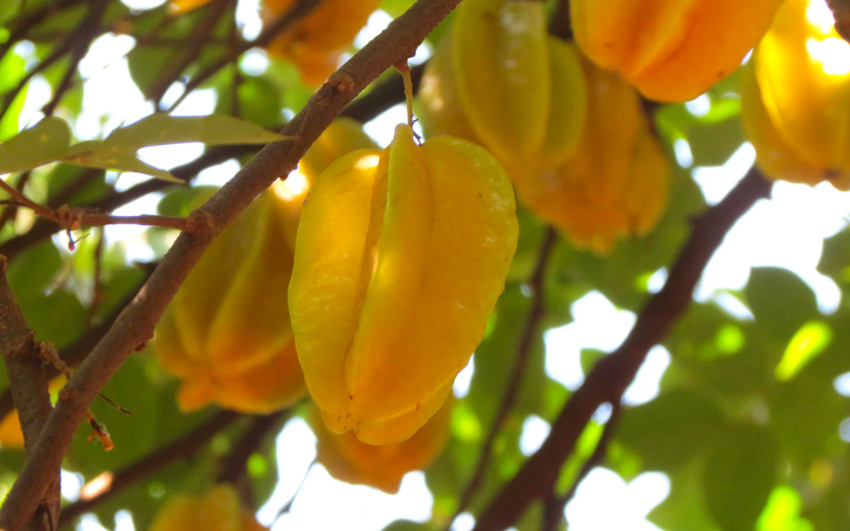
Carambola or Star fruit
But this is already a real star. Nothing decorates a dish as gracefully as sliced carambola. Yes, and it does not remain to the taste: juicy, moderately sweet, easily quenching thirst, pleasantly crispy on the teeth. There is a lot of vitamin C, but also a lot of oxalic acid, so in case of stomach problems it is better not to get carried away with carambola.
13. Nispero or Sapodilla
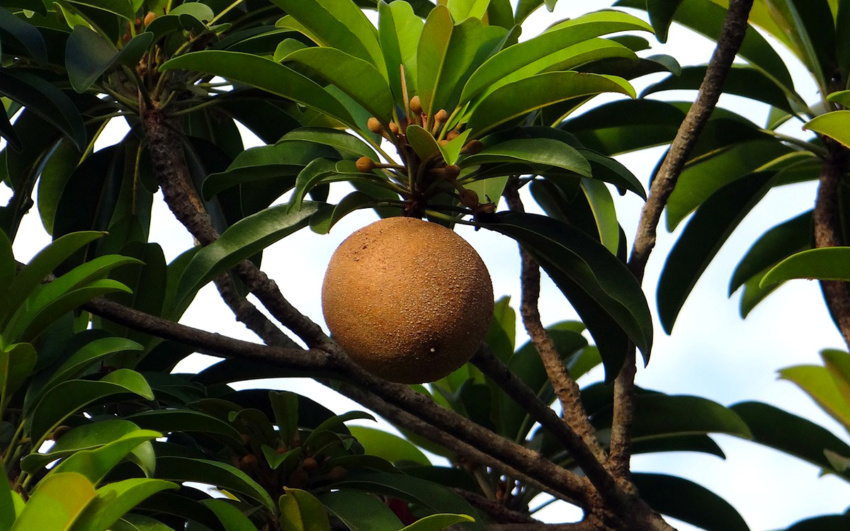
Nispero or Sapodilla
Cute light orange balls that look like a mixture of plums and potatoes, and taste like a mixture of pears, persimmons and quince. Nispero cleanses blood vessels and improves the functioning of the gastrointestinal tract, and most importantly – reduces sugar in diabetes. For Dominicans, who have an irresistible passion for sugar, nispero is a real lifesaver.
14. Mamey Sapote (Zapote)
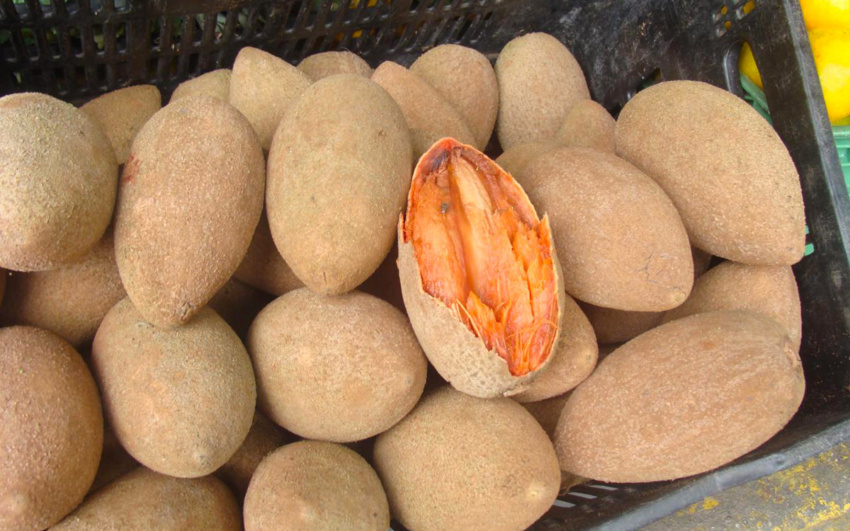
Mamey Sapote (Zapote)
This is a godsend for all those with a sweet tooth who want to stop eating chocolates, cookies and other store sweets. The red pulp of the sapote is very sweet, almost sugary, and appears to be very firm, although 85% of the fruit is water. It is high in fiber and vitamin C.
15. Cereza
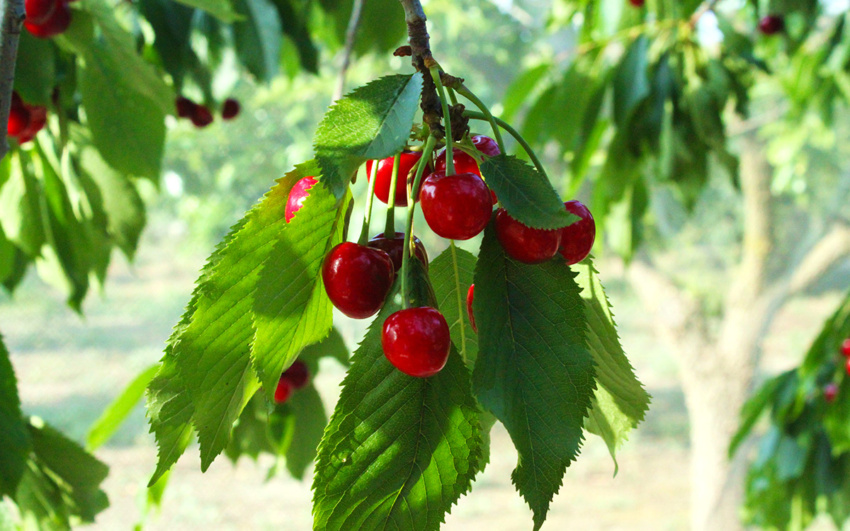
Cereza – Dominican cherry
To put it simply, Dominican cherry. Sweet, fragrant, it differs from ours in a large bone. The local cherries are also crisper and taste more like gooseberries or currants. In the Dominican Republic, drinks are made from this berry that resemble fruit drinks or compote. It is canned in sugar syrup, used for desserts and even when roasting meat. An excellent exotic berry to boost immunity. It is rich in vitamin C, antioxidants and is known for its diuretic properties. Delicious, healthy – you should taste it!
16. Sapodila or Chikoo

Sapodila or Chikoo
Sapodilla looks like a cross between kiwi and potatoes, and tastes like its relative sapote, but much honey. There is a whole bunch of antioxidants, vitamins and minerals here. Choose soft ripe fruits with dark brown skin and be careful: sapodilla is stored no longer than a couple of days, even in the refrigerator, and then begins to ferment.
17. Tamarind
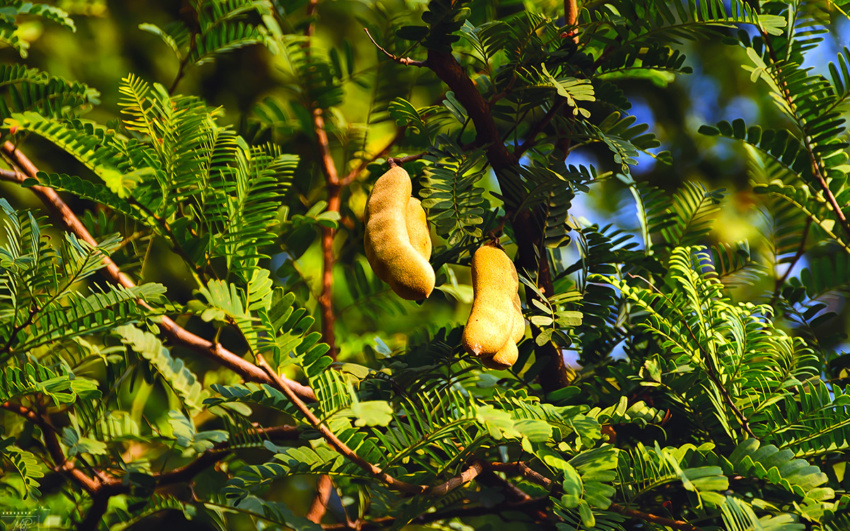
Tamarind
Tamarind is called “Dominican date” – these are beans in curved brownish pods, sour at first, and then, as they ripen, acquire an ever-sweeter taste. You can eat at any stage of maturity. Like dates, tamarind enjoys a well-deserved fame as an aphrodisiac.
The most popular fruits in the DR
1. Pineapple
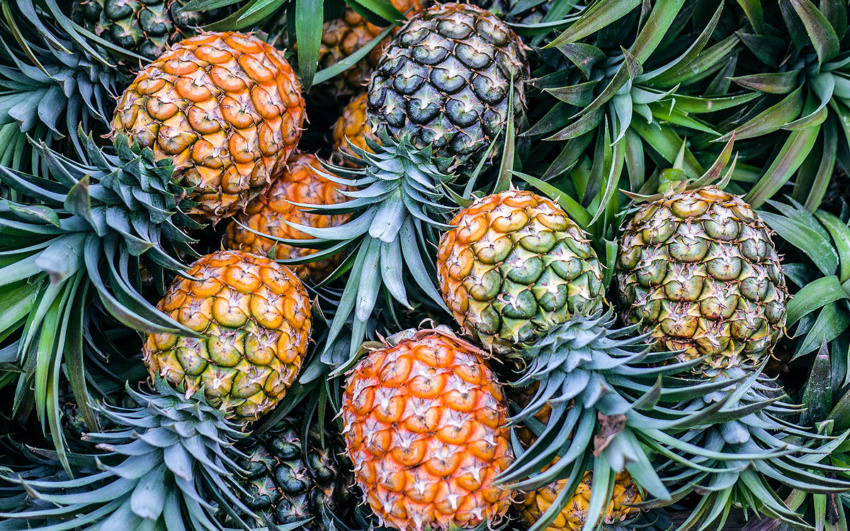
Pineapple
5 centuries ago, it was in the Dominican Republic that Columbus and his comrades first tasted pineapples. And to this day, travelers and the Dominicans themselves enjoy them with pleasure. Here they are the sweetest and most juicy! And also this fruit is incredibly important for your health: it is a real treasure of vitamins. Pineapple energizes, heals colds, fights cancer cells, lowers cholesterol, increases bone strength, improves skin, whitens teeth, and helps with brain activity and exercise.
2. Watermelon
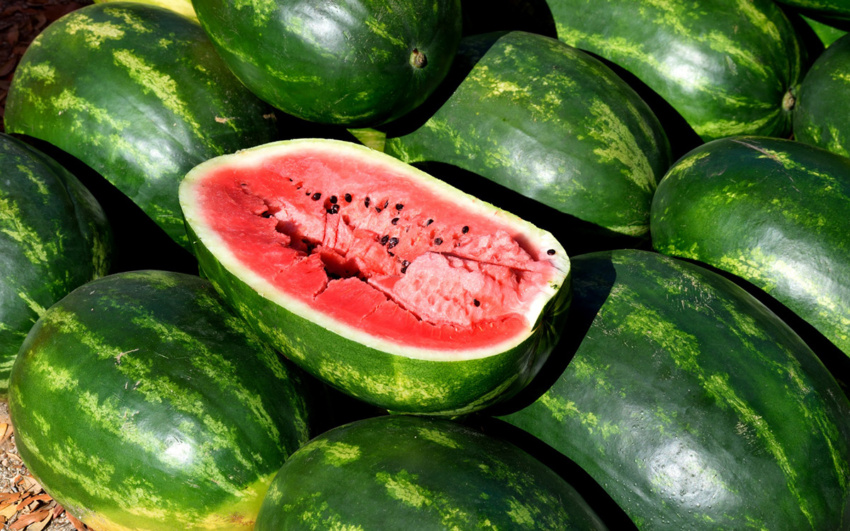
Watermelon
Watermelon is a storehouse of fiber, potassium and vitamins A and C. This green ball consists of 92% water. That is why it is so nice to gnaw a watermelon in the heat. It is also one of the lowest-calorie fruits – you can eat as much as you like. In the Dominican Republic, watermelons, like melons, are sweeter in summer: in winter, because of the shortened daylight hours, they do not get glucose.
3. Melon
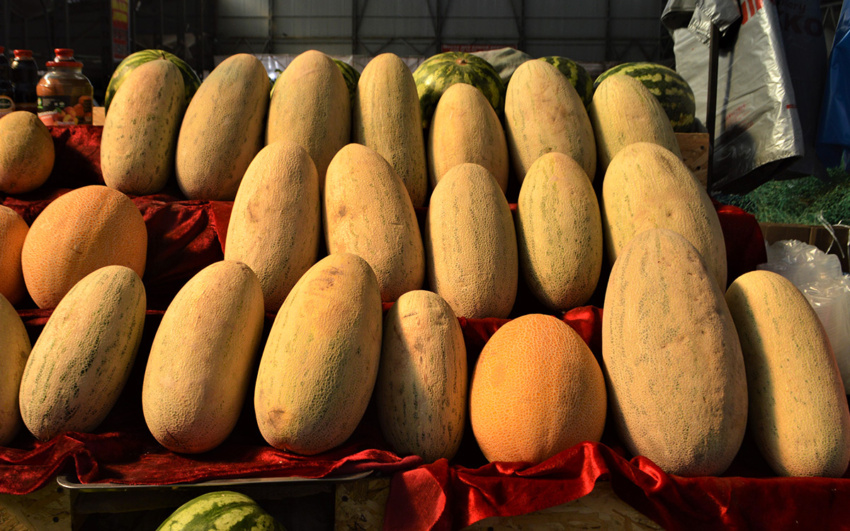
Melon
Melon is the best friend of everyone who strives to stay young as long as possible. A few slices a day will leave your hair thick, your skin smooth and shiny, your immune system strong and your mood sunny. The main thing is to eat the melon correctly: do not mix it with anything and eat it only a couple of hours before or a couple of hours after the main meal. And do not overdo it: melon is delicious, but in large quantities it is bad for the stomach.
4. Banana
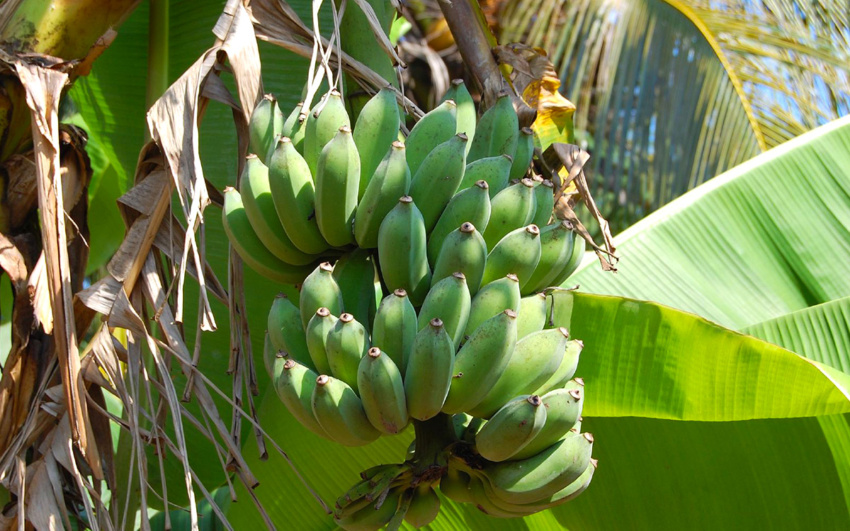
Banana
There are several types of them in the Dominican Republic. Small, soft and sweet are considered fruity. And the big and hard ones are vegetable, plane trees. The latter are not eaten raw, but cut into slices and deep-fried, or boiled and kneaded in manga puree. It tastes a lot like a potato dish. By the way, in fact, a banana is not a fruit or a vegetable, but… a berry. And they do not grow on palms, but on grass stalks. Banana also contains a record amount of vitamin B6, which is responsible for our good mood.
5. Mango
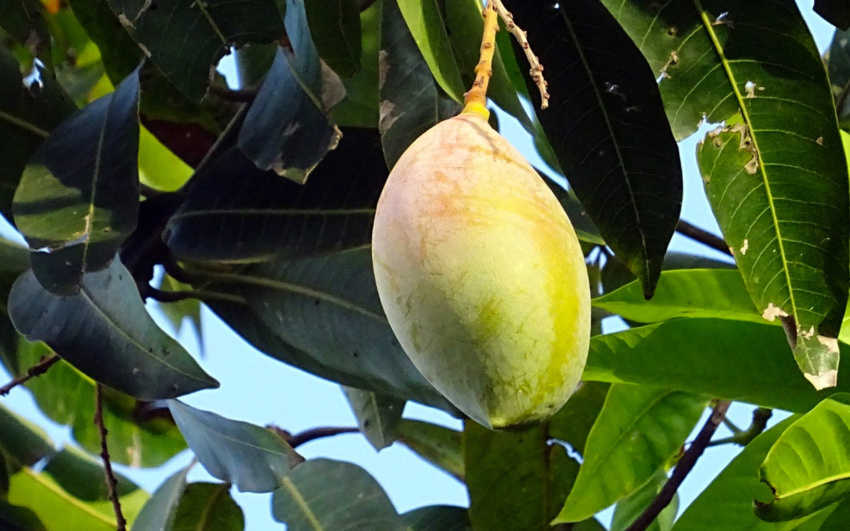
Mango
Some say that there are 40 types of mango in the Dominican Republic, others talk about 100 and more. You can check this once a year at the beginning of summer: in the village of Baní, the very one where mango ripens year-round, they organize a mango festival. There, farmers measure their yields and varieties, and for those who wish they organize a competition for a high-speed eating of this fruit. Mango is high in fiber, pectin and various minerals. The season is from April to October.
6. Avocado
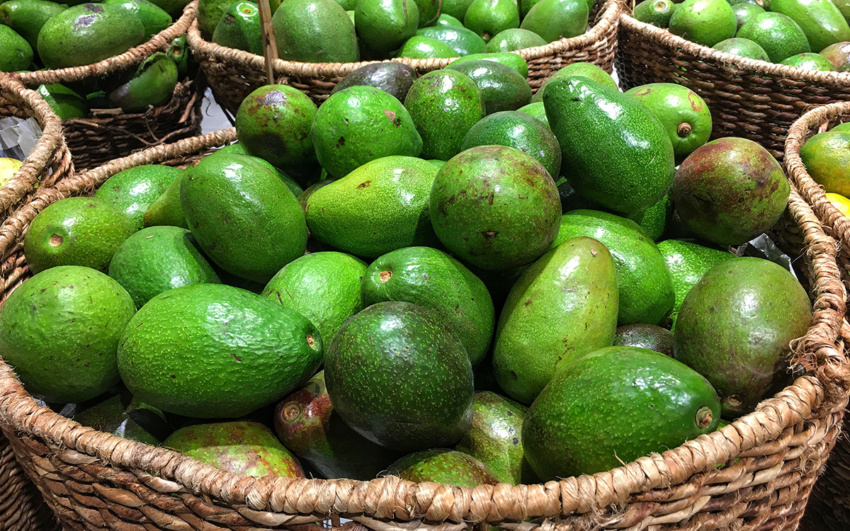
Avocado
Not everyone loves avocado, but this is only because not everyone has tasted it in the Dominican Republic. Avocados here are crazy: huge, with a delicious nutty smell, so soft that you can eat them with spoons – just scraping the pulp. This fruit is responsible for the healthy fats that lower cholesterol levels. And it itself is high-calorie, but nutritious. Avocado is also a pleasure not only to eat, but also to use for natural care – wonderful masks for face, body and hair are obtained from its pulp.
7. Coconut
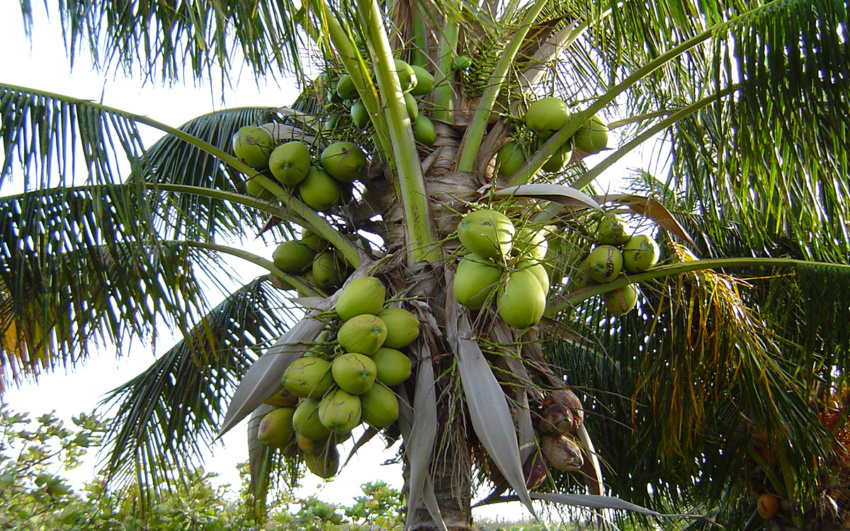
Coconut
Coconuts in the Dominican Republic are of two types: young green and brown mature. The former is appreciated for the sweet liquid, which refreshes even better than water in the heat. That is why coconuts can be bought on the beaches of Punta Cana and Boca Chica. The flesh of green nuts is tender, but not bright in taste. It looks like not sugary creamy jelly. In the Dominican Republic, brown nuts are used to squeeze oil, create candied fruits or shavings. Their water tastes slightly sour.
Coconut is the only fruit that is prohibited to export from the Dominican Republic, even in luggage. However, as well as from any other country.
8. Papaya

Papaya
Papaya in the Dominican Republic is called “lechoza”, from the word “leche” – milk. Milk is contained in the trunk of this amazing tree – and has the properties of a natural ambulance. If injured, cut the trunk of the lechoza tree and lubricate the wound with white juice. It will heal instantly. Well, the fruit itself contains a unique enzyme papain, reminiscent of gastric juice. Due to this, papaya is of great benefit to the digestive system.
When fruits are in season in the DR
We made the main fruits of the Dominican Republic in the seasonality table by month. It indicates the time of harvesting the fresh crop, but the fruits can be sold all year round. For example, the mango season in the Dominican Republic runs from April to November, but the markets sell fruit all year round. Just the lowest prices in the high season.
Dominican fruits by month
| Month | Fruits |
|---|---|
| January – February | Pineapples, oranges, bananas, grapefruits, guava, dragon fruit, coconuts, limes, lemons, mamoncillo, passion fruit, papaya, sapote, tamarind |
| March | Avocados, pineapples, oranges, watermelons, bananas, grapefruits, guava, dragon fruit, coconuts, limes, lemons, mamoncillo, passion fruit, nispero, papaya, sapote, tamarind |
| April | Avocados, pineapples, oranges, watermelons, bananas, grapefruits, guava, dragon fruit, coconuts, limes, lemons, mamoncillo, mangoes, passion fruit, nispero, papaya, sapote |
| May | Pineapples, watermelons, bananas, guava, dragon fruit, coconuts, mango, passion fruit, nispero, papaya, sapote |
| June – July | Pineapples, bananas, guava, guanábana, dragon fruit, coconuts, mango, passion fruit, papaya, sapote, cherimoya |
| August – September | Avocado, pineapple, banana, guava, guanábana, dragon fruit, carambola, coconuts, mango, passion fruit, papaya, sapote, cherimoya |
| October | Avocado, pineapple, banana, guava, dragon fruit, carambola, coconuts, passion fruit, papaya, sapote |
| November | Avocados, pineapples, oranges, bananas, grapefruits, guava, dragon fruit, carambola, coconuts, limes, lemons, mamoncillo, passion fruit, papaya, sapote, tamarind |
| December | Pineapples, oranges, bananas, grapefruits, guava, dragon fruit, coconuts, limes, lemons, mamoncillo, passion fruit, papaya, sapote, tamarind |
Important notes
First. Fruit prices vary greatly between tourist destinations and inland. Do not be surprised if a store in the hotel zone can sell fruit twice as expensive. Everyone wants to make more money on tourists.
Second. In the Dominican Republic, weight is used to measure in pounds, not kilograms. 1 pound = 0.45 kilograms. To make it easier to count, we recommend that you assume 2 pounds = 1 kilogram.
As a conclusion
The Dominican Republic is a Caribbean, tropical country which food is widely represented by all kinds of fruits. Some grow seasonally and others all year round. But once you come to the Dominican Republic, you can try any and even everything, but you will have to hunt hard for some. The fact is that some fruits ripen too quickly and are not suitable for transportation to hotels or supermarkets. Therefore, they can only be bought from the locals. Despite this, the fruits of the Dominican Republic will definitely not remain you indifferent! ¡Buen apetito!
Updated on: . Author:



